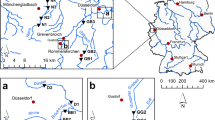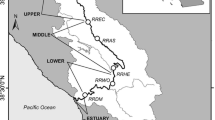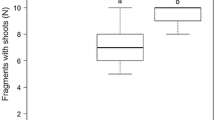Abstract
Plant dispersal and colonisation, including rates of dispersal, retention, colonisation and survival of dispersed propagules (shoots and seeds), were studied in a 300-m stream reach in a macrophyte-rich lowland stream during one growing season. Relationships between colonisation processes and simple flow parameters were tested. Each fortnight during a growing season, the number of dispersed plant propagules and the number of new and lost plant colonisations since the last sampling day were recorded. The retention of dispersing shoots was tested on two occasions during the growing season by releasing plant shoots and subsequently re-collecting the retained shoots in the study reach. The main bottleneck for plant colonisation in macrophyte-rich lowland streams is the primary colonisation (development of attached roots in the sediment from vegetative propagules or seedlings) of retained shoots and seeds, due in part to low retention success (1% of the dispersed shoots per 100-m reach) and to unsuccessful colonisation of retained shoots (3.4% of retained shoots colonised). The number of drifting shoots and seeds per day during the growing season were 650–6,950 and 2,970–62,780, respectively, and caused no constraint to colonisation. The survival rate of primary colonists was high with 80% surviving during the first growing season and about 50% surviving the first winter. There was no relationship between number of drifting shoots and flow, but the number of drifting seeds increased with flow. The number of colonisations between two consecutive sampling days correlated to the extent of low flow in the period. The loss rate of colonisations correlated to high flow events, but was low overall. My study strongly indicates that the number of propagules is not a constraint to colonisation in macrophyte-rich lowland streams. Rather, I conclude that primary colonisation is the main constraint to regaining vegetation in lowland streams in general and in vegetation-free rehabilitated streams in particular. Therefore, if plant colonisation is a target for stream rehabilitation, it is important to enhance retention and colonisation of propagules by creating areas of low flow and by providing physical obstacles to work as retention agents in the stream.





Similar content being viewed by others
References
Baattrup-Pedersen A. & T. Riis, 2004. Impacts of different weed cutting practices on macrophyte species diversity and composition in a Danish stream. River Research and Application 20: 103–114.
Baattrup-Pedersen, A., S. E. Larsen & T. Riis, 2003. Composition and richness of macrophyte communities in small Danish streams—influence of environmental factors and weed cutting. Hydrobiologia 495: 171–179.
Bakker, J. P., T. Poschold, R. J. Strykstra, R. M. Bekker & K. Thompson, 1996. Seed banks and seed dispersal: important topics in restoration ecology. Acta Botanica Neerlandica 45: 461–469.
Barrat-Segretain, M. H. & G. Bornette, 2000. Regeneration and colonization abilities of aquatic plant fragments: effect of disturbance seasonality. Hydrobiologia 421: 31–39.
Barrat-Segretain, M. H., G. Bornette & A. Hering-Vilas-Boas, 1998. Comparative abilities of vegetative regeneration among aquatic plants growing in disturbed habitats. Aquatic Botany 60: 201–211.
Barrat-Segretain, M. H., C. P. Henry & G. Bornette, 1999. Regeneration and colonisation of aquatic plant fragments in relation to the disturbance frequency of their habitats. Archieve fur Hydrobiologie 45: 111–145.
Boedeltje, G., J. P. Bakker, R. M. Bekker, J. M. Van Groendal & M. Soesberg, 2003. Plant dispersal in a lowland stream in relation to occurrence and three specific life-history traits of the species in the species pool. Journal of Ecology 91: 855–866.
Boedeltje, G., J. P. Bakker, A. ten Brinke, J. M. Van Groendal & M. Soesberg, 2004. Dispersal phenology of hydrochorous plants in relation to discharge, seed release time and buoyancy of seeds: the flood pulse concept supported. Journal of Ecology 92: 786–796.
Bullock, J. M., I. L. Moy, R. F. Pywell, S. J. Coulson, A. M. Nolan, & H. Caswell, 2002. Plant dispersal and colonization processes at local and landscape scale. In Bullock J. M., K. E. Kenward & R. S. Hails (eds), Dispersal Ecology. Blackwell Publication, Oxford, UK.
Dawson, F. H., E. Castellano, & M. Ladle, 1978. Concept of species succession in relation to river vegetation and management. Verhandlungen Internationale Vereinigung für Theoretische and Angewandte Limnologie 20: 1439–1444.
Flint, N. A. & J. D. Madsen, 1995. The effect of temperature and daylength on the germination of Potamogeton nodosus tubers. Journal of Freshwater Ecology 10: 125–128.
Johansson, M. E. & C. Nilsson, 1993. Hydrochory, population dynamics and distribution of the clonal aquatic plant Ranunculus lingua. Journal of Ecology 81: 81–91.
Kaenel, B. R., B. C. Matthaei & U. Uehlinger, 1998. Disturbance by aquatic plant management in streams: effects on benthic invertebrates. Regulated Rivers: research & management 14: 341–356.
Merritt, D. M. & E. E. Wohl, 2002. Processes governing hydrochory along rivers: hydraulics, hydrology, and dispersal phenology. Ecological Applications 12: 1071–1087.
Moeslund, B., B. Løjtnant, H. Mathiessen, L. Mathiessen, A. Pedersen, N. Thyssen & J. C. Schou, 1990. Danske Vandplanter (in Danish). Environmental News No. 2. Danish Environmental Protection Agency, Copenhagen.
Pickett, S. T. A. & M. J. McDonell, 1989. Changing perspectives in community dynamics: a theory of successional forces. Trends in Ecology and Evolution 4: 241–245.
Riis T., K. Sand-Jensen & S. E. Larsen, 2001. Plant distribution and abundance in relation to physical conditions and location within Danish stream systems. Hydrobiologia 448: 217–228.
Riis, T. & B. J. F. Biggs, 2003. Hydrologic and hydraulic control of macrophytes in streams. Limnology and Oceanography 48: 1488–1497.
Riis, T. & K. Sand-Jensen, 2006. Dispersal of plant fragments in small streams. Freshwater Biology 51: 274–286.
Sand-Jensen, K., 2003. Drag and reconfiguration of freshwater macrophytes. Freshwater Biology 48: 271–283.
Sand-Jensen, K. & J. Mebus, 1996. Fine-scale patterns of water velocity within macrophyte patches in streams. Oikos 76: 69–80.
Sand-Jensen, K., E. Jeppesen, K. Nielsen, L. van der Bijl, A.-L. Hjermind, L. W. Wiggers & T. M. Iversen, 1989. Growth of macrophytes and ecosystem consequences in a Danish lowland stream. Freshwater Biology 22: 15–32.
Sand-Jensen, K., K. Andersen & T. Andersen, 1999. Dynamic properties of recruitment, expansion and mortality of macrophyte patches in streams. International Review of Hydrobiology 84: 497–508.
Sculthorpe, C. D., 1967. The Biology of Aquatic Vascular Plants. Edward Arnold, London.
Smith, D. H., J. D. Madsen, K. L. Dickson & T. L. Beitinger, 2002. Nutrient effect on autofragmentation of Myriophyllum spicatum. Aquatic Botany 74: 1–17.
Spencer, D. F. & G. G. Ksander, 1992. Influence of temperature and moisture on vegetative propagule germination of Potamogeton species—implications for aquatic plant management. Aquatic Botany 43: 351–364.
Spencer, D. F., W. VanViessen, F. J. Ryan & G. G. Ksander, 1993. Influence of photoperiod and plant weight on tuber production by Potamogeton pectinatus L. Journal of Freshwater Ecology 8: 1–11.
van Wijk, R. J. & J. A. J. Trompenaars, 1985. On germination of turions and life cycle of Potamogeton trichoides Cham. et Scheld. Aquatic Botany 22: 165–172.
Wiegleb, G., W. Herr & D. Todeskino, 1989. Ten years of vegetation dynamics in two rivulets in Lower Saxony (FRG). Vegetatio 82: 163–178.
Wilcock, R. J., P. D. Champion, J. W. Nagels & G. F. Croker, 1999. The influence of aquatic macrophytes on the hydraulic and physico-chemical properties of a New Zealand lowland stream. Hydrobiologia 416: 203–214.
Acknowledgements
I thank Ole Bennike, Geological Survey of Denmark and Greenland (GEUS) for helping with seed identification and Ole Zahrtmann for helping with field work. I also thank The Danish Natural Science Research Council for financial support.
Author information
Authors and Affiliations
Corresponding author
Additional information
Handling editor: L. M. Bini
Rights and permissions
About this article
Cite this article
Riis, T. Dispersal and colonisation of plants in lowland streams: success rates and bottlenecks. Hydrobiologia 596, 341–351 (2008). https://doi.org/10.1007/s10750-007-9107-0
Received:
Revised:
Accepted:
Published:
Issue Date:
DOI: https://doi.org/10.1007/s10750-007-9107-0




